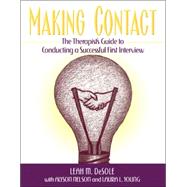
Note: Supplemental materials are not guaranteed with Rental or Used book purchases.
Purchase Benefits
What is included with this book?
| Introduction | |
| Preparing to Make Contact with Your Client | |
| Settling Into Your Site | |
| Orient yourself to your site | |
| Identify your sitersquo;s protocol: Mission and philosophy | |
| Clarify the population your site serves | |
| Elucidate your supervisorrsquo;s expectations of you | |
| Familiarize yourself with the physical setting of your site | |
| Practical Issues in Preparing to See Your Client | |
| Feel comfortable with your role in the first interview | |
| Arrange the space in which you will initially meet with patients | |
| Clarify the paperwork that the first interview entails | |
| Understand what you communicate when you make a first appointment | |
| Direct your patient to the agency where you will meet for the initial contact | |
| Preparing Emotionally to See Your Client | |
| Explore your feelings about being in training | |
| Examine your feelings about engaging in clinical work | |
| Acknowledge the fears that you have about meeting a client for the first time | |
| Identify your expectations in relation to the first interview | |
| Develop techniques and strategies to prepare emotionally to see your client | |
| Seeing Yourself as a Professional | |
| See yourself as a professional | |
| Define and identify the levels of professional communication | |
| Understand your sitersquo;s expectations | |
| Integrate yourself with your professional style | |
| Meeting Your Client for the First Time | |
| The Beginning phase | |
| Establish rapport in your first client session | |
| Learn how to introduce yourself, manage time boundaries and greet clients | |
| Clarify expectations: Confidentiality, consent, role distinctions and final questions | |
| The Middle Phase | |
| Define the middle phase of the first interview | |
| Describe the foundation: Taking a non-directive, biopsychosocial approach | |
| Identify content: Opening questions, presenting problems and symptoms | |
| Examine process: Pacing, making transitions and monitoring session depth | |
| The End Phase | |
| Bring the session to a close | |
| Manage process: Facilitate termination, encourage dialogue and convey hope | |
| Clarify content: Wind down; review concerns, get feedback and take next steps | |
| Handle closing concerns: Collect payment, doorknob syndrome and final statement | |
| When Special Circumstances Arise | |
| Dealing with Difficult Clients | |
| Distinguish among different types of difficult clients in the first interview | |
| Form a picture of your ideal client | |
| Identify difficult clients: Chatty, vague, deceitful, hostile and potentially violent clients | |
| Recognize clients who may be difficult for you | |
| Use yourself as an instrument | |
| Sensitive Subjects | |
| Identify and handle subjects you find difficult as a new clinician | |
| Talk to clients about sensitive subjects | |
| Determine how deeply to delve into sensitive subjects in the first interview | |
| Recognize and intervene in crisis situations in the first interview | |
| Suicidal and Homicidal Patients | |
| Review your professional responsibility for suicidal and homicidal patients | |
| Clarify the myths and facts about suicide | |
| Inquire about suicidal ideation in the first interview | |
| Develop strategies for responding to a positive risk a | |
| Table of Contents provided by Publisher. All Rights Reserved. |
The New copy of this book will include any supplemental materials advertised. Please check the title of the book to determine if it should include any access cards, study guides, lab manuals, CDs, etc.
The Used, Rental and eBook copies of this book are not guaranteed to include any supplemental materials. Typically, only the book itself is included. This is true even if the title states it includes any access cards, study guides, lab manuals, CDs, etc.